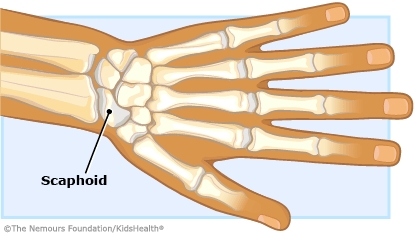The scaphoid, a small bone in the wrist, can fracture (break) when someone falls on their hand to stop a fall or has a direct blow to the hand. Treatment for a scaphoid (SKA-foid) fracture is a cast or splint to hold the bone in place so it can heal. A cast is a hard bandage that goes all the way around the hand and wrist. A splint has supports that are held in place by straps or an elastic bandage. Kids who got a splint at first will get a cast after a few days. The orthopedic (bone) specialist will see your child regularly and might do more imaging tests (such as an X-ray or MRI) to make sure the bone is healing well.

- Follow your health care provider's recommendations for:
- caring for the cast or splint
- doing exercises to keep the shoulder, elbow, and fingers strong and flexible
- whether your child should go to physical therapy
- what activities to avoid (such as sports)
- when to follow up
- any protective gear needed after the cast is removed
- Smoking and chewing tobacco can make it harder for the bone to heal. Your child should not smoke or chew tobacco. If your child or someone in your household needs help quitting, they can call 800-QUIT-NOW or visit smokefree.gov for advice and support.
To control swelling, for the first 2 days after the injury:
- Use pillows to raise the cast above heart level when your child is sitting or lying down.
- When your child is awake, put ice in a plastic bag wrapped in a towel on the outside of the cast or splint for 20 minutes every 3 hours. Don't put ice directly on the cast or skin.
- Have your child wiggle their fingers throughout the day.
If your child has pain:
- Put ice in a plastic bag wrapped in a towel on the outside of the cast or splint for 20 minutes every 3 hours. Don't put ice directly on the cast or skin. Ask your health care provider if it's OK to use ice for longer than 2 days after the injury.
- If your health care provider says it's OK, you can give medicine such as acetaminophen (Tylenol® or a store brand) or ibuprofen (Advil®, Motrin®, or a store brand). Follow the package directions for how much to give and how often.
Taking care of a cast or splint:
- Keep the cast or splint clean. Keep dirt, sand, lotions, and powder away from it.
- Don't let your child scratch under the cast or splint or put anything in it.
- Don't pick at or remove the padding from the edges.
- Check the area daily. Make sure the skin is not scratched and the fingers are not pale, blue, numb, or tingling.
- Keep it dry during bathing. Younger children can get a sponge bath. For regular baths or showers, you can cover the cast or splint with:
- two plastic bags sealed at the top with a rubber band (or tape)
- plastic wrap covered with a plastic bag that is sealed at the top
- a waterproof cast protector
- If it gets splashed, blow air into the cast or splint from a hair dryer on the cool setting.
Problems to watch for:
- Swelling: If the fingers get swollen, have your child raise them above heart level for up to an hour.
- Sharp cast edges: If the skin near or under the cast gets red or irritated, put tape or moleskin (available at drugstores) on the edges.
- Itching: Don't let your child scratch or put anything into the cast for itching. Instead, tap lightly on the cast or use a hair dryer on the cool setting to blow air in and around the edge.

Your child can't move their fingers, or the fingers look white, purple, or blue.

How is a scaphoid fracture diagnosed? To diagnose a fracture, health care providers ask how the injury happened, do an exam, and get an X-ray. Even if the X-ray doesn't show a fracture, they'll put a cast or splint on if they think the bone may be broken based on how the injury happened and the exam. This keeps the bone in place until more tests (such as another X-ray or MRI) can be done to check the bone again.
How is a scaphoid fracture treated? The bone needs to be kept still so that it can heal. If a splint is placed first, it will be replaced by a cast after a few days. Depending on where the bone broke and if it is out of place, the cast will stay on for 6–20 weeks. During that time, the health care provider will check every few weeks to make sure the bone is healing. Some scaphoid fractures will need to be fixed with surgery.
What happens after the cast comes off? After the cast is removed, your child may need physical therapy to help strengthen the wrist and make it more flexible. They also might need to wear a brace or splint during sports and activities to protect the wrist for a few months.




